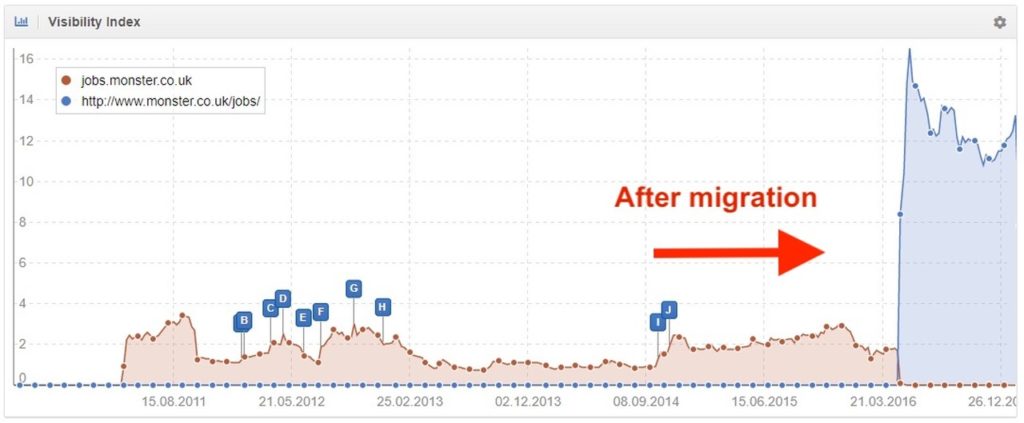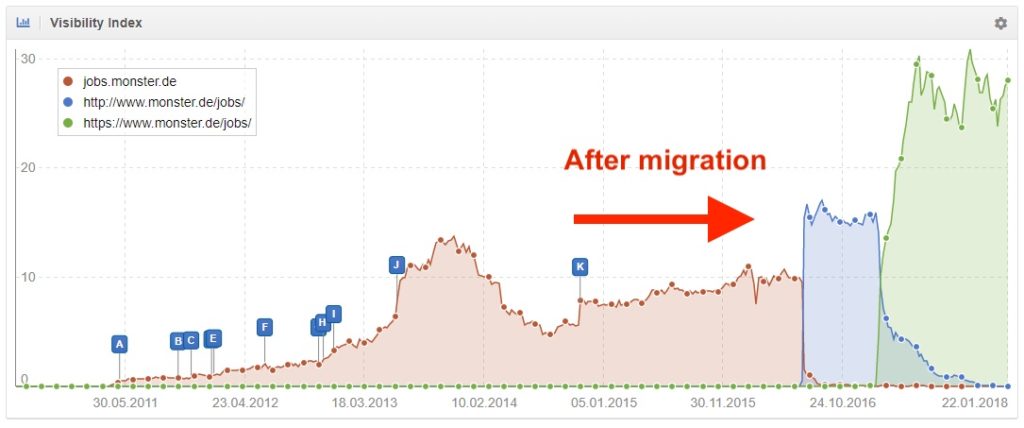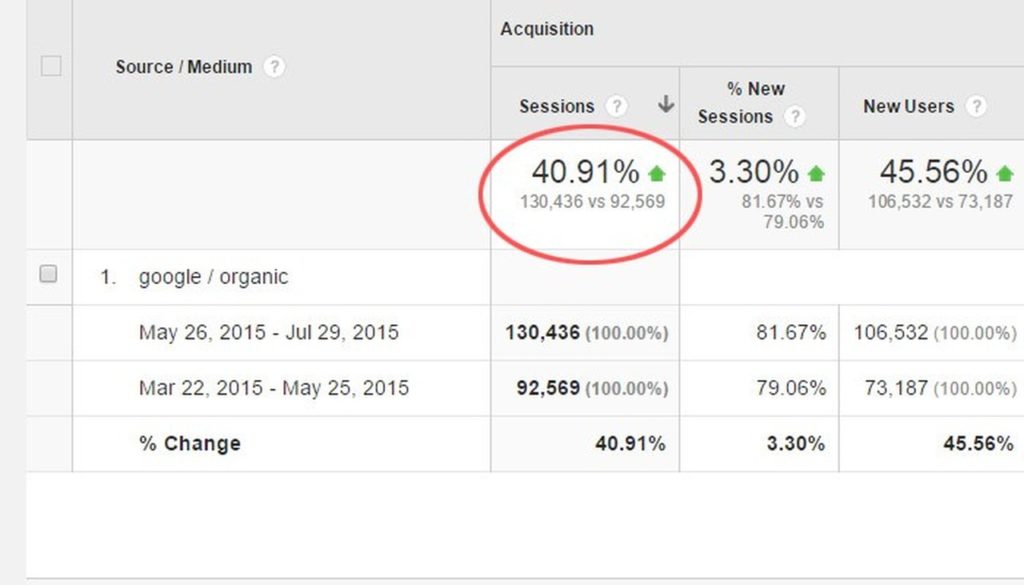In the world of SEO, there is a great debate concerning whether it is better to have a website subdomain or a subfolder. This article is an effort to shed some light on this subject. We will explore the differences between these two options and will examine a few case studies to see the impacts of migration.
One of the most common issues website owners run into is whether or not to house content, such as a blog, on a subdomain (blog.example.com) or keep it under a subfolder (example.com/blog) on the primary domain.
What’s our take on it?
We believe that when it comes to choosing between a subdomain or a subfolder for SEO value, subfolders almost always win as the better choice for website health and better rankings. We’ll share more about that later.
First, let’s explain what a subdomain is.
What is a Subdomain?
A subdomain is a subsection of any primary domain, but is a separate website from the primary domain website. For example, if your primary domain is https://www.nike.com/, a subdomains would be this news section on the Nike site (https://news.nike.com/). The Nike News site is a standalone website and is separate from the primary website. However, the Nike News site still shares a related domain to the primary site.
Subdomains such as the Nike New sites can help users navigate through very large websites, which can support a better user experience, and can also support a branding strategy to differentiate between sub-brands under the umbrella of a large parent brand.
What is a Subfolder or Subdirectories?
On the other hand, subfolders, also known as subdirectories, are located under the main domain, such as this Career Advice section from Monster.com (https://www.monster.co.uk/career-advice/).
Subfolders are straightforward and can be easy to navigate to since they are hosted under a folder on the main website as opposed to a different domain.
This could look like a section of the site that is accessible from the navigation menu such as the Career Advice section on Monster.co.uk.
However, URL structure is not necessarily the primary driver for SEO benefits when comparing the difference between a subdomain and subfolder. Rather, the advantages of housing content under a subfolder come from increased opportunities for internal linking and keyword rankings, as well as improved site architecture and technical health.

Is Subdomain or Subfolder better for SEO?
Although there is never a one-size-fits-all solution to this common question, in many cases, subdomains are an ineffective strategy for organic growth and should be utilized for a different purpose, such as branding.
In contrast, subfolders can be an effective vehicle in supporting search visibility and rankings, as outlined in the case studies below.
Therefore, we encourage website owners to consider the potential benefits of housing content in a subfolder rather than a subdomain.
Hosting Content on a Subdomain
Pros (+)
- Helpful for very large websites
- Helpful for branding
- Can be used for a staging website
Cons (-)
- Can be more difficult to rank for keywords
- Can be more resource-intensive
- Considered a separate site, doesn’t support link equity
There are a number of pros and cons for hosting content on a subdomain as opposed to a subfolder.
Subdomains are useful in the context of brand management and user experience for very large websites. As seen with Nike’s news site, this subdomain allows users to easily distinguish the news department from the primary website, and helps users navigate between the primary site and subdomain without confusion.
Subdomains can also be an effective staging website for developers who want to test changes before pushing them live.
However, Google may treat your subdomain differently if it carries different content from your main domain. Google’s Search Advocate, John Mueller has said:
“I would personally try to keep things together as much as possible. So if it’s the same site then try to put them on the same site, essentially, and use subdomains where things are really kind of slightly different.”
Another issue is that Google still sees subdomains as a separate site from the primary domain, which carries its own site performance. Mueller has also said:
“You’ll need to verify subdomains separately in Search Console, make any changes to settings, and track overall performance per subdomain.”
Since Google recognizes subdomains as individual websites unique from the main domain’s performance, this creates more difficulty for a subdomain to transfer any value to the primary domain since it establishes individual keyword rankings and authority apart from the primary site.
In addition, any links to the main domain would not pass any value to the subdomain and vice versa. As a result, subdomains would require more resources and effort to create strong, organic visibility, which can be a challenge for many companies.
Hosting Content on a Subfolder
Pros (+)
- Creates a cohesive site
- Link equity is passed to the main domain
- Can strengthen overall site traffic and keyword rankings
Cons (-)
- Requires strategic planning
- May cause lack of brand clarity
On the other hand, hosting content under subfolders creates significant SEO advantages by strengthening the primary domain in a variety of ways.
First, hosting additional content on the primary site creates more opportunities for ranking keywords and user traffic. Content diversity on a website can boost site impressions and search visibility for a wider range of keywords, which can encourage traffic from different audiences.
Second, a larger content library allows you to establish strong site architecture through internal links, which contributes to your site’s technical health and search engine rankings. Diverse blog content also increases the likelihood of gaining backlinks from other websites and shares on social media, both of which are necessary components for strong organic performance.
Third, housing all content on the main domain, as opposed to a subdomain, will create a focused, cohesive website that carries more overall authority. Ultimately, one well-built, strong domain will outrank two sites (a domain and subdomain) with mediocre authority.
The only downsides to hosting content on a subfolder is that it may cause some brand confusion and will require strategic planning in relation to site architecture and user experience. Marketing and SEO teams will need to collaborate on finding the best way to communicate branding as they silo new content on the primary domain. Teams will also need to plan a comprehensive internal link strategy to keep content accessible to both crawlers and users alike.

Subfolder Case Studies
There are numerous supporting industry case studies that exhibit the clear, positive effects of moving content from to a subfolder rather than keeping it on a subdomain.
Wirecutter and New York Times
Earlier this year, at SMX Advanced, keynote speaker Jaimie Clark (VP of SEO at Centerfield and former head of SEO at Wirecutter) shared her experience of migrating the Wirecutter website under the New York Times brand and subdirectory back in 2020.
Wirecutter is a product review site that was acquired by the New York Times in 2016. After the acquisition, Clark spearheaded the strategy to migrate the Wirecutter site under the New York Times brand, a move that invited both praise and criticism.
 Image source: https://marketinglandevents.com/smx/advanced/agenda/#sessId-1569
Image source: https://marketinglandevents.com/smx/advanced/agenda/#sessId-1569
 Image source: https://marketinglandevents.com/smx/advanced/agenda/#sessId-1569
Image source: https://marketinglandevents.com/smx/advanced/agenda/#sessId-1569

Image source: https://marketinglandevents.com/smx/advanced/agenda/#sessId-1569
However, her bold strategy paid off immensely. Not only did Wirecutter have a huge upgrade in its number of backlinks (30k to 1.6 million), but the site also made massive gains in visibility because of New York Times’ authority. Post migration, Wirecutter’s content became regularly featured in Google’s news carousels (a difficult feat in itself), and best of all, post-migration traffic to the site doubled in the same year.
Monster.com Case Study
Another case study focused on Monster.com’s UK and Germany subdomains. Both sites showed a significant change in traffic and visibility after migrating subdomain content to subfolders on the main domain (jobs.monster.co.uk was moved to monster.co.uk/jobs/ and jobs.monster.co.de was moved to monster.co.de/jobs/).
After the migration, Monster.com.uk increased its visibility by 116%, while Monster.com.de also saw a significant increase in traffic.
 Image source: https://www.sistrix.com/blog/subdomains-vs-subdirectories/
Image source: https://www.sistrix.com/blog/subdomains-vs-subdirectories/
 Image source: https://www.sistrix.com/blog/subdomains-vs-subdirectories/
Image source: https://www.sistrix.com/blog/subdomains-vs-subdirectories/
Pink Cake Box Case Study
One other case study that demonstrates the SEO benefits of a subfolder is the blog, Pink Cake Box. The blog was founded in 2005, and hosted on a subdomain, which was created to boost the primary domain’s authority and visibility. The blog migrated from subdomain to a subfolder on the primary domain in 2015, a move that increase organic traffic to the primary domain by 40%.
 Image source: https://medium.com/@pinkcakebox/how-a-single-change-boosted-organic-traffic-by-40-b0c6105d5ca1
Image source: https://medium.com/@pinkcakebox/how-a-single-change-boosted-organic-traffic-by-40-b0c6105d5ca1
Other examples of this similar trend are shared below:
- In this tweet from John Doherty, moving their Hotpads blog from subdomain to subfolder showed traffic increases.
- In a reverse case study, this website owner saw traffic losses after moving their blog from subfolder to a subdomain.
Conclusion
Although each situation is unique, there are a number of advantages to housing content under a subfolder of a primary domain versus a subdomain.
Unless created for branding purposes, subdomains are not an ideal strategy for organic visibility since they do not offer as many SEO benefits as a subfolder. Since Google sees subdomains as a separate entry from a primary domain, subdomains do not contribute to the primary domain’s performance nor do they support search visibility, and therefore, are not effective solutions for organic growth.
However, subfolders remain a steadfast best practice because of its ability to support a domain’s technical health while encouraging traffic growth and keyword rankings.
Read other interesting articles from our blog on how to improve your Google website ranking, free SEO tools, and more!
References
- Fishkin, Rand. “Subdomains vs. Subfolders, Rel Canonical vs. 301, and How to Structure Links for Seo.” Moz, https://moz.com/blog/subdomains-vs-subfolders-rel-canonical-vs-301-how-to-structure-links-optimally-for-seo-whiteboard-friday
- Gonzalez, Juan. “Case Study: Monster’s Monster Growth on Google.” SISTRIX, 24 Jan. 2018, https://www.sistrix.com/blog/case-study-monsters-monster-growth-on-google/
- Heap, Jesse. “Case Study: How a Single Change Boosted Organic Traffic by 40%.” LinkedIn, LinkedIn, 9 Aug. 2018, https://www.linkedin.com/pulse/case-study-how-single-change-boosted-organic-traffic-40-jesse-heap/
- Emerson, Craig. “Subdomains vs Subdirectories Seo Guide.” Blogging Flail, 15 July 2021, https://www.bloggingflail.com/subdomains-vs-subdirectories-seo/
- “Developing authoritative content that Google ranks and searchers need.” Marketing Land Events, SMX Advanced, 15 June 2022, https://marketinglandevents.com/smx/advanced/agenda/#sessId-1569 Accessed 25 Aug. 2022.
- Burstein, Daniel. “Subfolders, Subdirectories and Subdomains: The URL Difference That Can Drive a Major Increase in Organic Traffic.” MarketingSherpa Blog, 28 Mar. 2018, https://sherpablog.marketingsherpa.com/search-marketing/subfolders-subdirectories-subdomains-url-difference-increase-organic-traffic/
- https://twitter.com/dohertyjf/status/563868669864734721
- https://twitter.com/ruthburr/status/746119726946914304
- “Subdomain or Subfolder, Which Is Better for SEO?” https://www.youtube.com/watch?v=uJGDyAN9g-g
- Southern, Matt G. “Google Treats Subdomains and Subdirectories the Same, John Mueller Says.” Search Engine Journal, 29 May 2018, https://www.searchenginejournal.com/google-treats-subdomains-subdirectories-john-mueller-says/254687/#close.
- Montti, Roger. “Subdomains vs. Subfolders: Which Is Better for Seo & Why?” Search Engine Journal, 12 Feb. 2021, https://www.searchenginejournal.com/subdomains-vs-subfolders-seo/239795/#close







